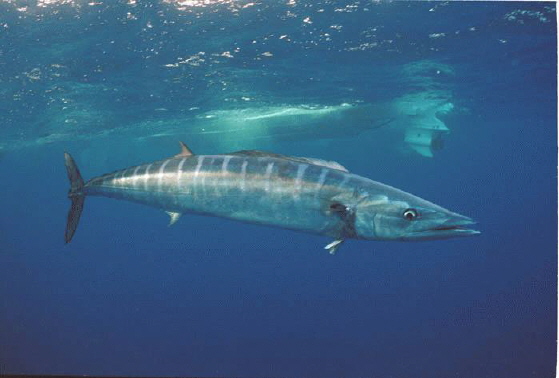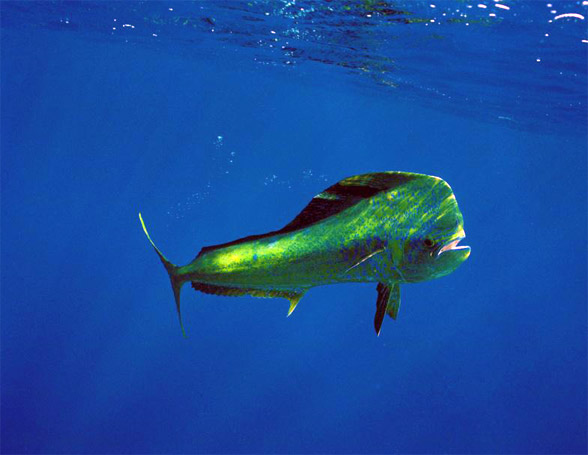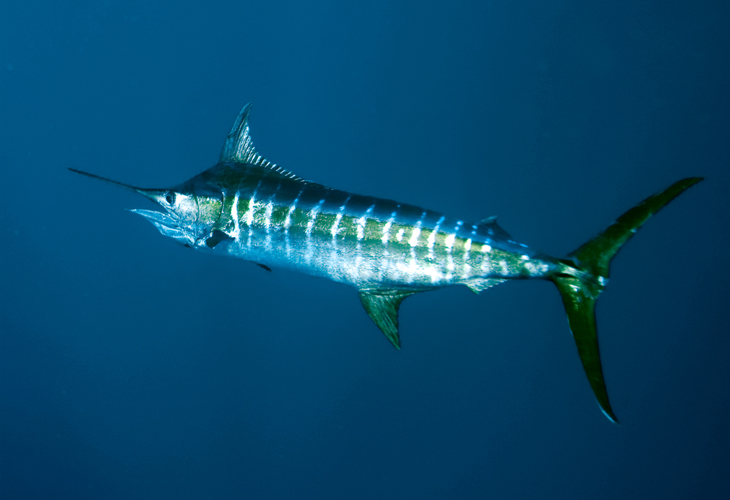

Many anglers have theories based around the sun and moon phases, which is left up to you to figure what you agree with. However, to be a good Angler, one must consider all possible options with an open mind. From our research, the effects of the ocean’s tides and moon phases are intertwined with when fish feed. Fish tend to feed on moving tides, therefore, being effected by the number of tides and strength of these tides. Since the tides are affected and generated by the moon, the fishing can be better or worse based on any given period of the moon phase. For the most part, many captains like to fish on the building side or the waxing phase of the moon. Many captains feel the few days before and after a full moon are the peak times of the month for marlin fishing. This coincidentally is also a time when the tides tend to be stronger and more frequent as well. So as we see it, an animal is connected with it's ecosystem and therefor held by influence via the moon. Keep in mind, there are many other factors of influence at play in the ecosystem of a fish.
Consider a fishing trip with some of the best Captains of Hawaii
Ahi, also called Yellowfin Tuna
The Ahi is among the larger tuna species, ranging as high as 2.4 m (94 in)
in length and 200 kg (440 lb) in weight. The name comes from the second dorsal fin and
the anal fin, as well as the finlets between those fins and the tail, as they are
bright yellow. The main body is a very dark metallic blue, changing to silver on the
belly, which has about 20 vertical lines.
Ahi are able to escape most predators, because unlike most fish, Ahi are
warm-blooded, and their warm muscles make them extremely strong swimmers, with
Ahi reaching "speeds of up to 50 miles per hour". (They can navigate
enormous distances, sometimes crossing entire oceans.)
Aku, also called Skipjack Tuna.
Aku is a medium-sized perciform fish in the tuna family, Scombridae. It grows up to 3
ft in length.
Aku is a streamlined, fast-swimming pelagic fish, common in tropical waters throughout
the world, where it inhabits surface waters in large shoals (up to 50,000 fish),
feeding on fish, crustaceans, cephalopods, and molluscs. It is an important prey
species for large pelagic fishes and sharks. It has no scales, except on the lateral
line and the corselet (a band of large, thick scales forming a circle around the body
behind the head). It commonly reaches lengths up to 31 in and a weight of 18–22 lb.
Its maximum fork length is 43 in and maximum weight is 76 lb. Aku estimates a lifespan
range between 8 and 12 years.
Blue Marlin.
Blue marlin are distributed throughout the tropical and subtropical waters of the
Atlantic, Indian, and Pacific Oceans. A bluewater fish that spends the majority of its
life in the open sea far from land, the blue marlin preys on a wide variety of marine
organisms, mostly near the surface. It uses its bill to stun, injure, or kill while
knifing through a school of fish or other prey, then returns to eat the injured or
stunned fish.
Marlin is a popular game fish with a relatively high fat content. The biggest females
are more than four times as heavy as the biggest males, which rarely exceed 350 lb in
weight. The longest females can reach a length of 16 ft with the bill, constituting
about 20% of the total body length - making their body mass about 1,190 to 1,810 lb.
Mahi Mahi, also called Dorado or Dolphin Fish.
The mahi-mahi means "very strong" in Hawaiian (also known widely as dorado) is a
surface-dwelling ray-finned fish found in off-shore temperate, tropical and
subtropical waters worldwide.
Mahi-mahi have compressed bodies and a single long-based dorsal fin extending from the
head almost to the tail. Their caudal fins and anal fins are sharply concave. They are
distinguished by dazzling colors: golden on the sides, and bright blues and greens on
the sides and back. Mature males have prominent foreheads protruding well above the
body proper. Females have a rounded head. Females are also usually smaller than males.
Ono, also called Wahoo.
In Hawaii, the wahoo is known as ono. Ono is found worldwide in tropical and subtropical seas. It is best known to sports fishermen for its speed and high-quality flesh make it a prize game fish.
Ono's body is elongated and covered with small, scarcely visible scales; the back is an iridescent blue, while the sides are silvery, with a pattern of irregular vertical blue bars and have razor sharp teeth. These colors fade rapidly at death. The mouth is large, and both the upper and lower jaws have a somewhat sharp appearance.
Specimens have been recorded at up to 8 ft in length, and weighing up to 183 lb, growth is known to be rapid. Ono can swim up to 60 mph. They are some of the fastest fish in the sea!
Sailfish.
Sailfish live in warmer sections of all the oceans of the world. They are predominately blue to gray in colour and have a characteristic erectile dorsal fin known as a sail, which often stretches the entire length of the back. Another notable characteristic is the elongated bill, resembling that of the swordfish and other marlins. They are therefore described as billfish.
Sailfish are highly prized game fish, and are known for their incredible jumps and great speed. They can swim 100 m in 4.8 sec. They can appear in a startling array of colours, from subdued browns and grays to vibrant purples and even silver. Their body colours are often highlighted by stripes of iridescent blue and silver dots. Sailfish can change their colours almost instantly—a change controlled by their nervous system. The sailfish can rapidly turn its body light blue with yellowish stripes when excited, confusing its prey and making capture easier, while signalling its intentions to fellow sailfish.
Striped Marlin
The striped marlin is a small species of marlin found in tropical to temperate Indo-Pacific oceans not far from the surface. It is seasonally migratory, moving toward the equator during the cold season and away again during the warm season. It weighs in around 420 lb and a length of 13.8 ft. The striped marlin is a predator that hunts during the day in the top 100 metres or so of the water column, often near the surface. One of their chief prey is sardines.
It has an elongated body, a spear-like snout or bill, and a long, rigid dorsal fin which extends forward to form a crest. This dorsal fin is the most distinguishing characteristic, which normally equals or exceeds the greatest body depth. Even in the largest specimens this fin is at least equal to 90 percent of the body depth. Its common name is thought to derive from its resemblance to a sailor's marlinspike. Marlins are fast swimmers, reaching speeds of about 50 mph.
catch your own today!!
The striped marlin is a small species of marlin found in tropical to temperate Indo-Pacific oceans not far from the surface. It is seasonally migratory, moving toward the equator during the cold season and away again during the warm season. It weighs in around 420 lb and a length of 13.8 ft. The striped marlin is a predator that hunts during the day in the top 100 metres or so of the water column, often near the surface. One of their chief prey is sardines.
It has an elongated body, a spear-like snout or bill, and a long, rigid dorsal fin which extends forward to form a crest. This dorsal fin is the most distinguishing characteristic, which normally equals or exceeds the greatest body depth. Even in the largest specimens this fin is at least equal to 90 percent of the body depth. Its common name is thought to derive from its resemblance to a sailor's marlinspike. Marlins are fast swimmers, reaching speeds of about 50 mph.
The Striped Marlin is highly predatory, feeding extensively on pilchards, anchovies, mackerel, sauries, flying fish, squid, and whatever is abundant. It is well known for its fighting ability and has the reputation of spending more time in the air than in the water after it is hooked. In addition to long runs and tail walks, it will “greyhound” across the surface, making up to a dozen or more long, graceful leaps. It can be caught fairly close to shore, and lacking the size and weight of the blue marlin or the black marlin, it is more acrobatically inclined. Fishing methods include trolling whole fish, strip baits, or lures; also live bait fishing
In Hawaii, the wahoo is known as ono. Ono is found worldwide in tropical and subtropical seas. It is best known to sports fishermen for its speed and high-quality flesh make it a prize game fish. 
The flesh of the Ono is white to grey, delicate to dense, and highly regarded by many gourmets. The taste is similar to mackerel, though arguably less pronounced. In many areas of its range, such as Hawaii, local demand for Ono is met by artisanal commercial fishermen, who take them primarily by trolling, as well as by recreational sports fishermen who sell their catch.
Ono's body is elongated and covered with small, scarcely visible scales; the back is an iridescent blue, while the sides are silvery, with a pattern of irregular vertical blue bars and have razor sharp teeth. These colors fade rapidly at death. The mouth is large, and both the upper and lower jaws have a somewhat sharp appearance.
Specimens have been recorded at up to 8 ft in length, and weighing up to 183 lb, growth is known to be rapid. Ono can swim up to 60 mph. They are some of the fastest fish in the sea!
Ono tend to be solitary or occur in loose-knit groups of two or three fish, but where conditions are suitable can be found in schools as large as 100 or more. Their diet is made up of other fish and squid.
Catch Ono today! Book now
Mahi-mahi means "very strong" in Hawaiian (also known widely as dorado) is a surface-dwelling ray-finned fish found in off-shore temperate, tropical and subtropical waters worldwide. 
Mahi-mahi can live up to 5 years, although they seldom exceed four. Catches average 15 to 29 lb. They seldom exceed 33 lb, and mahi-mahi over 40 lb are exceptional.
Mahi-mahi have compressed bodies and a single long-based dorsal fin extending from the head almost to the tail. Their caudal fins and anal fins are sharply concave. They are distinguished by dazzling colors: golden on the sides, and bright blues and greens on the sides and back. Mature males have prominent foreheads protruding well above the body proper. Females have a rounded head. Females are also usually smaller than males.
The pectoral fins of the mahi-mahi are iridescent blue. The flank is broad and golden. 3 black diagonal stripes appear on each side of the fish as it swiftly darts after prey.
Out of the water, the fish often change color, going though several hues before finally fading to a muted yellow-grey upon death.
Mahi-mahi are among the fastest-growing fish. They spawn in warm ocean currents throughout much of the year, and their young are commonly found in seaweed. Mahi-mahi are carnivorous, feeding on flying fish, crabs, squid, mackerel, and other forage fish. They have also been known to eat zooplankton and crustaceans.
Mahi-mahi often swim near debris such as floating wood, palm trees and fronds, or sargasso weed lines and around fish buoys.
Mahi-mahi are highly sought for sport fishing and commercial purposes. Sport fishermen seek them due to their beauty, size, food quality, and healthy population. 
Thirty- to fifty-pound gear is more than adequate when trolling for mahi-mahi. Fly-casters may especially seek frigatebirds to find big mahi-mahis, and then use a bait-and-switch technique. Ballyhoo or a net full of live sardines tossed into the water can excite the mahi-mahis into a feeding frenzy. Hookless teaser lures can have the same effect. After tossing the teasers or live chum, fishermen throw the fly to the feeding mahi-mahi. Once on a line, mahi-mahi are fast, flashy and acrobatic, with beautiful blue, yellow, green and even red dots of color.
Blue marlin are distributed throughout the tropical and subtropical waters of the Atlantic, Indian, and Pacific Oceans. A bluewater fish that spends the majority of its life in the open sea far from land, the blue marlin preys on a wide variety of marine organisms, mostly near the surface. It uses its bill to stun, injure, or kill while knifing through a school of fish or other prey, then returns to eat the injured or stunned fish.
Marlin is a popular game fish with a relatively high fat content. The biggest females are more than four times as heavy as the biggest males, which rarely exceed 350 lb in weight. The longest females can reach a length of 16 ft with the bill, constituting about 20% of the total body length - making their body mass about 1,190 to 1,810 lb.
The marlin has two dorsal fins and two anal fins. The fins are supported by bony spines known as rays. Its first anal fin, along with its pectoral and caudal fins, can be folded into grooves. This streamlines the fish and thereby reduces drag.
Blue marlin, like other billfish, can rapidly change color. However, the body is most often blue-black on top with a silvery white underside. It has about 15 rows of pale, cobalt-colored stripes, each of which has round dots and/or thin bars, located on both sides of the fish. The body is covered with thick, bony, elongated scales 
The bill is long and stout. Both the jaws and the roof of the mouth are covered with small, file-like teeth. The nerves in the mouth are so sensative, they can feel weak water motions and large changes in pressure.
Blue marlin are found year-round in tropical oceanic waters of the Atlantic and Indo-Pacific. The range expands into temperate waters of the Northern and Southern Hemispheres during the warmer months and contracts towards the Equator during colder months.
Once blue marlin reach maturity, they have few predators, with the most important probably being large pelagic sharks such as the shortfin mako and great white shark. Other potential predators include toothed whales such as the false killer whale and killer whale.
Catch one today!